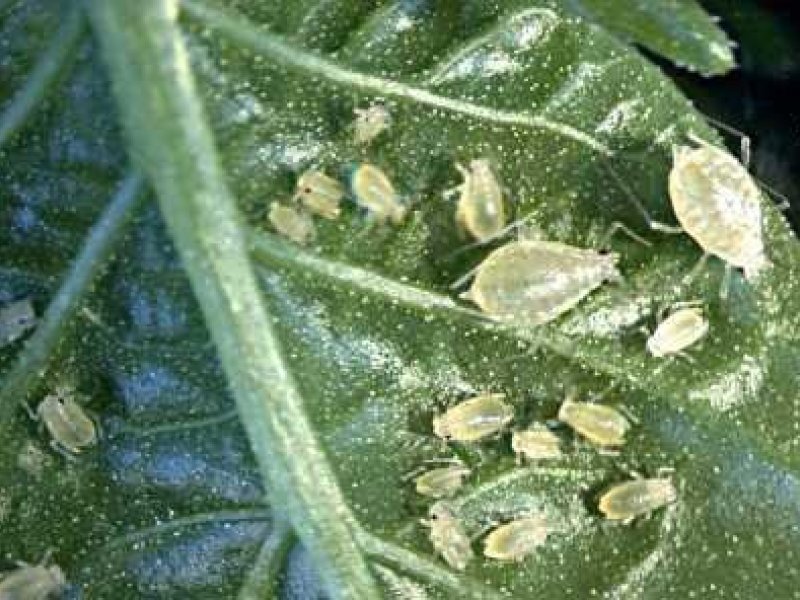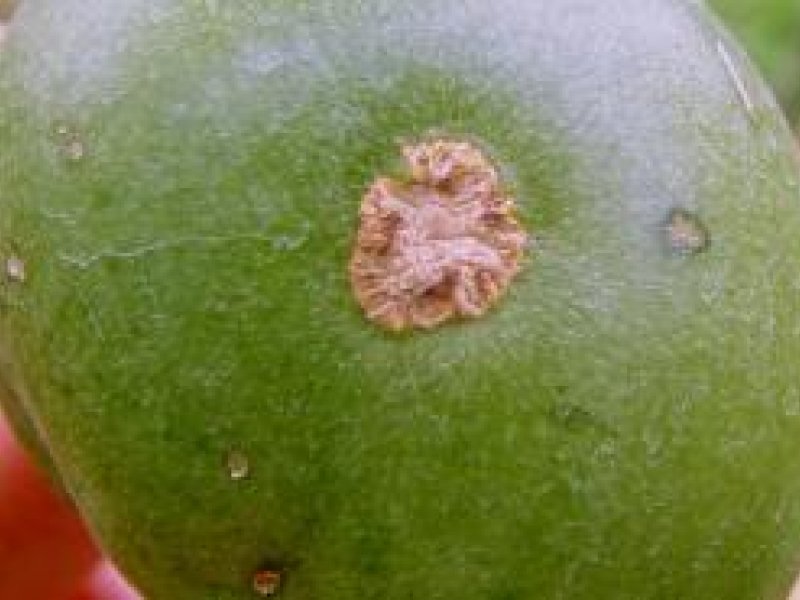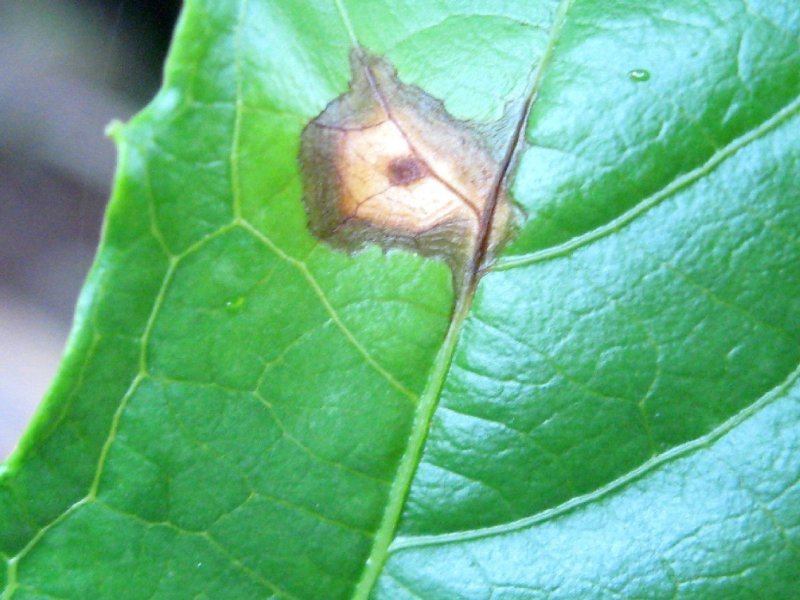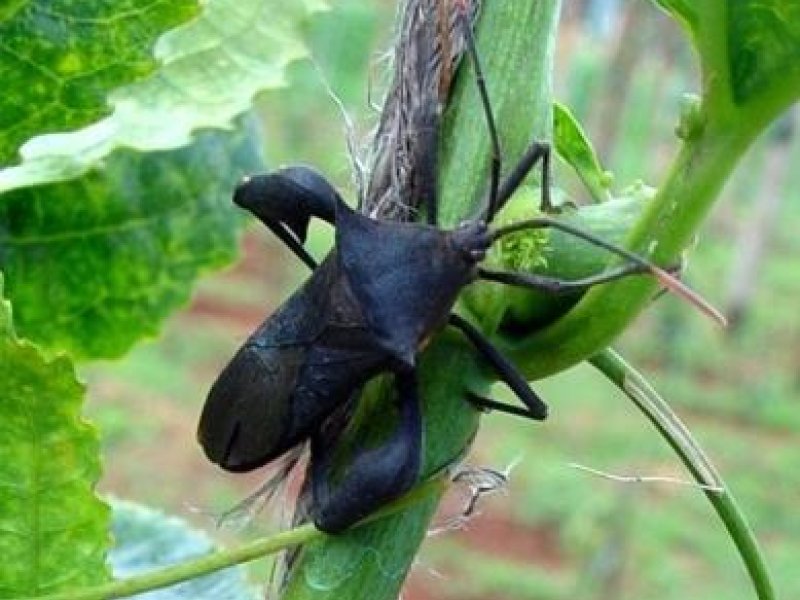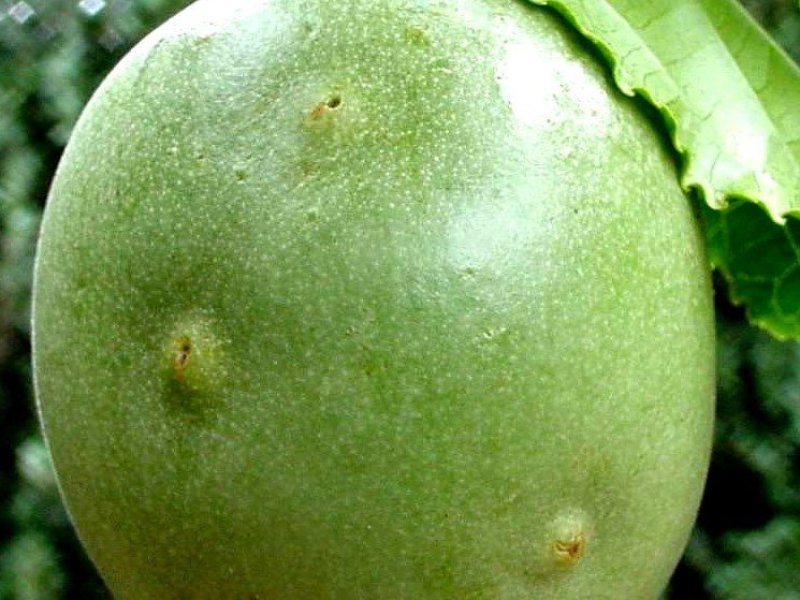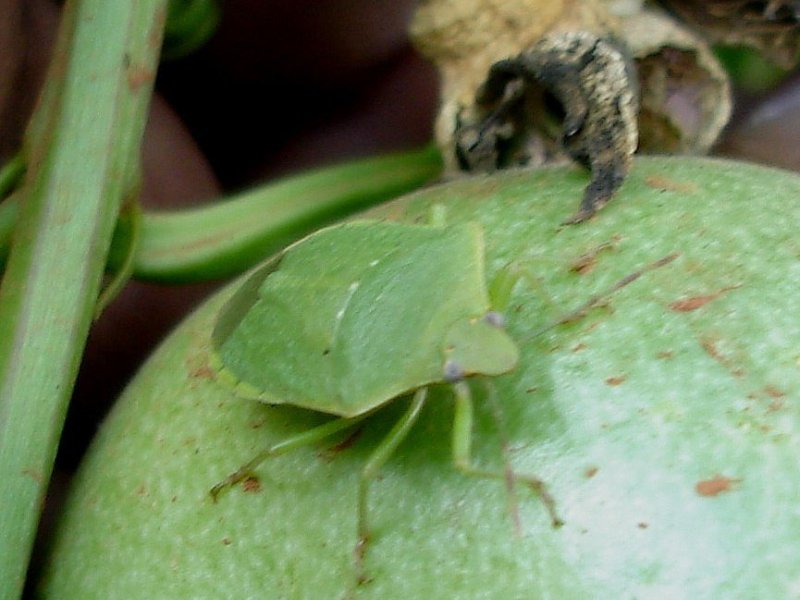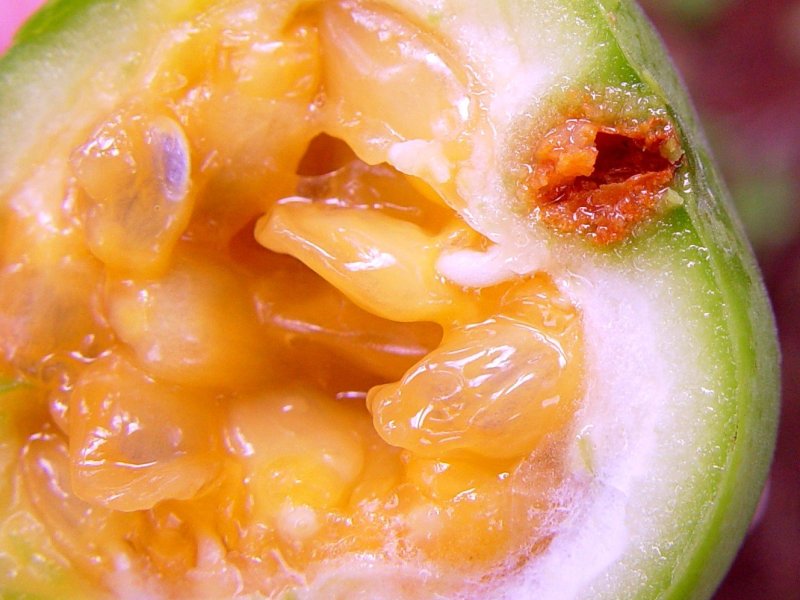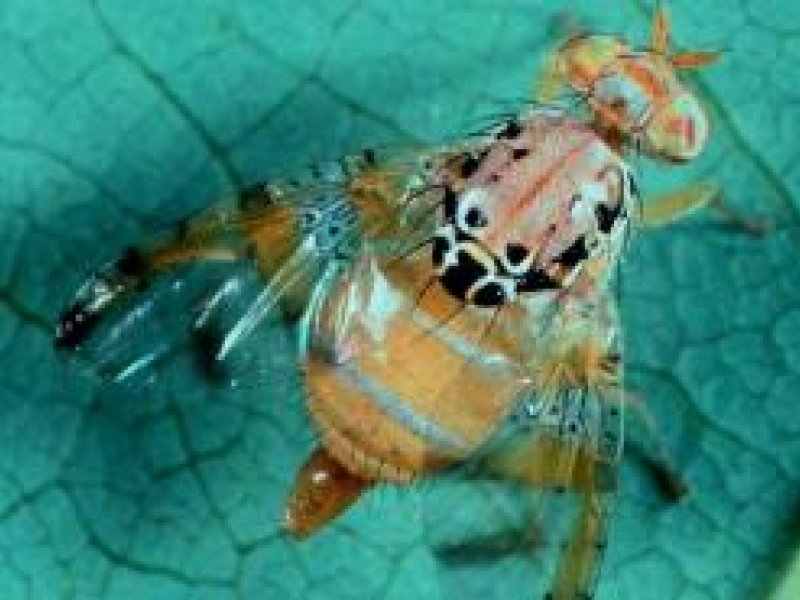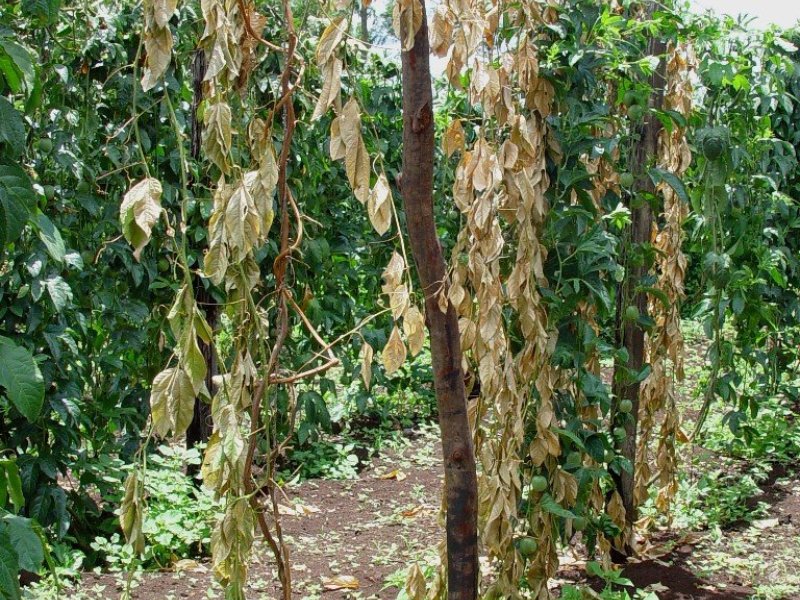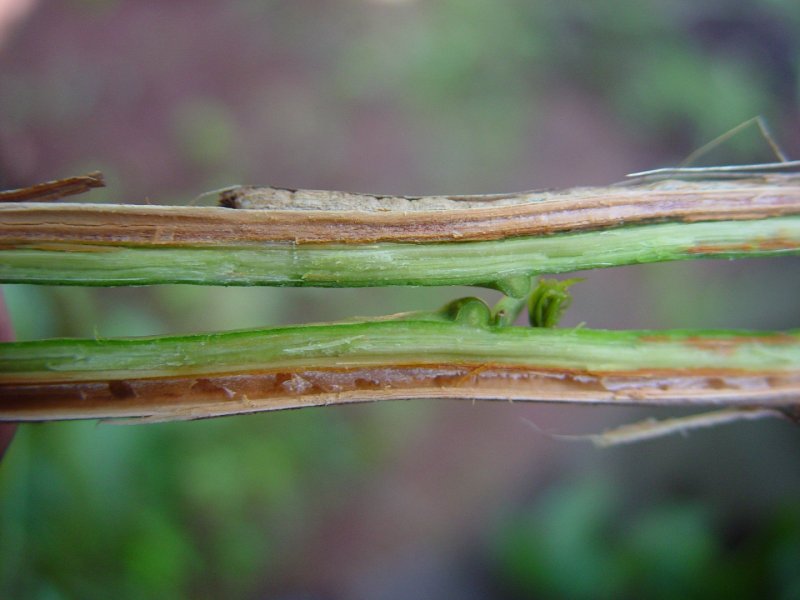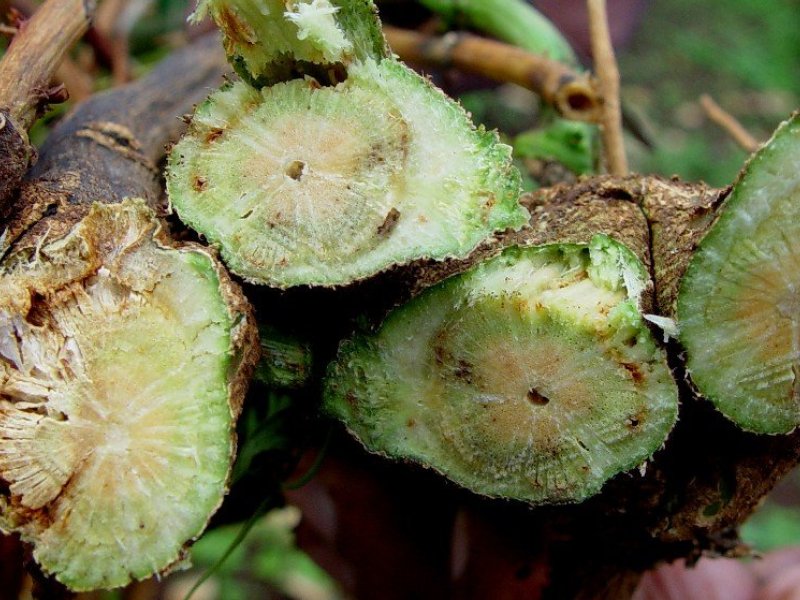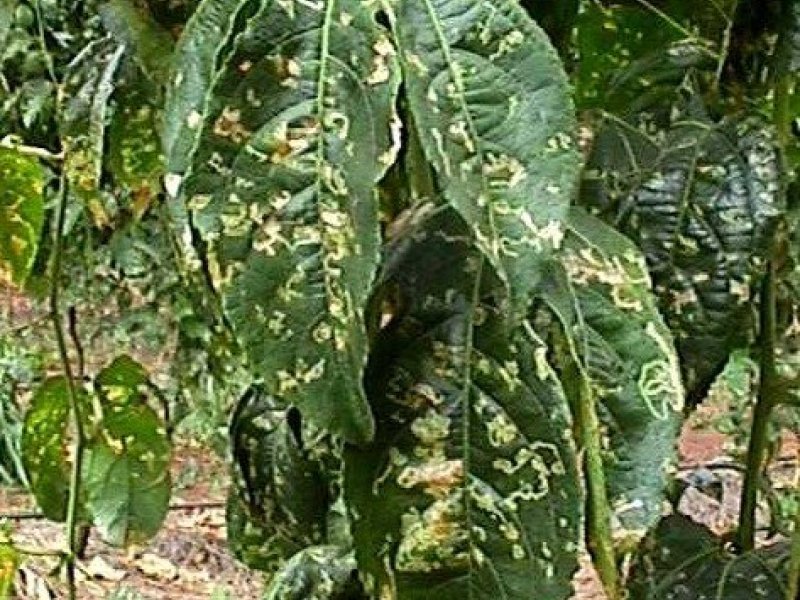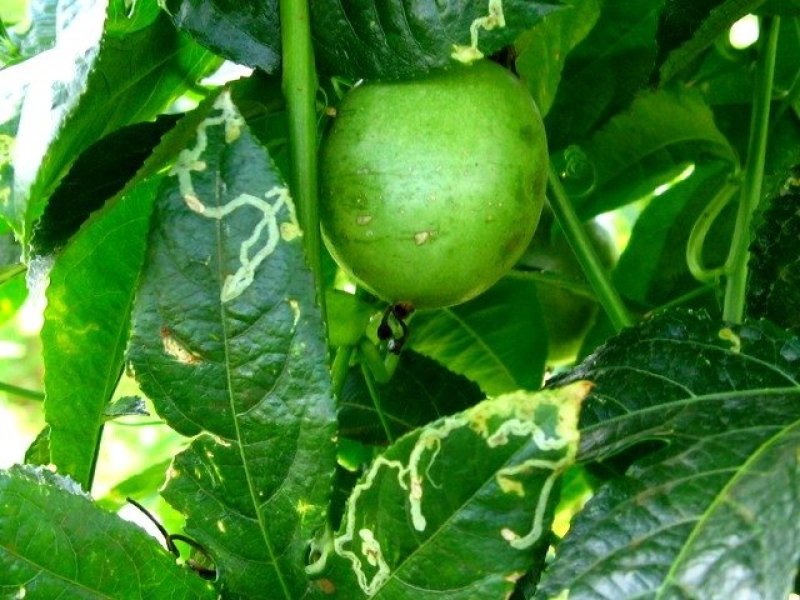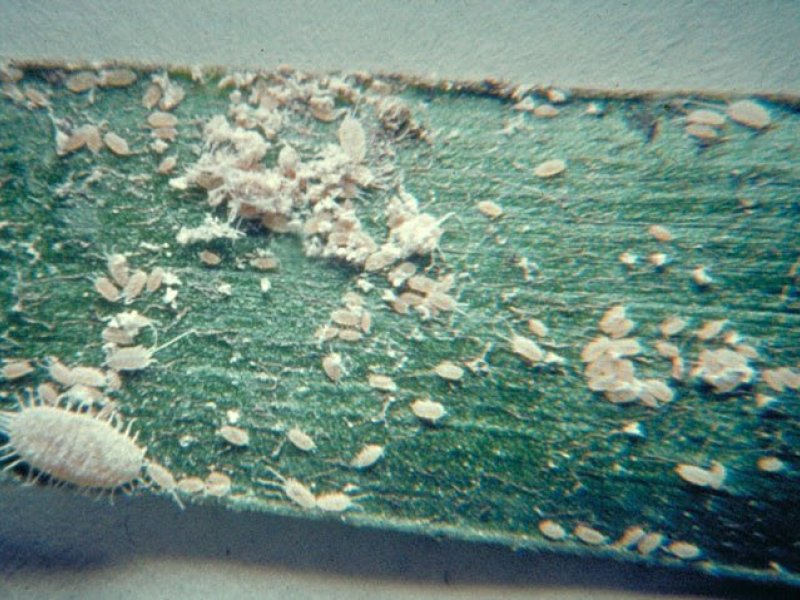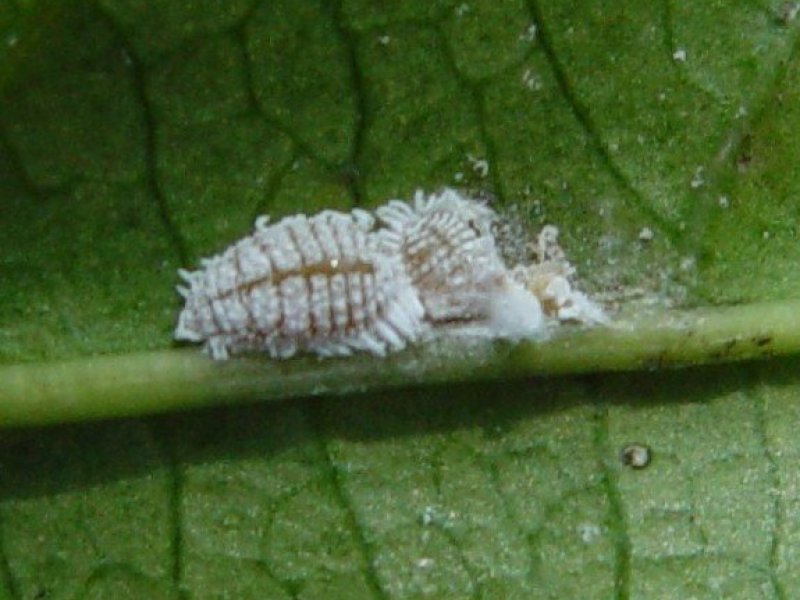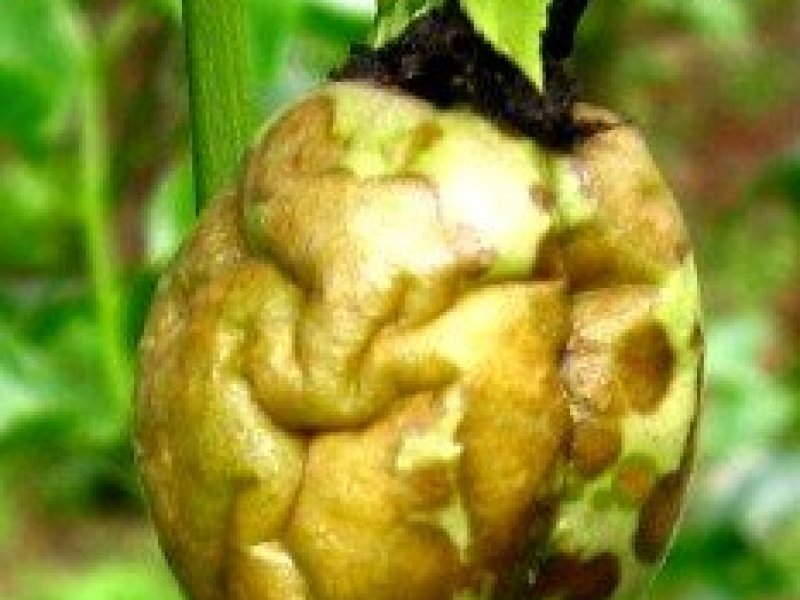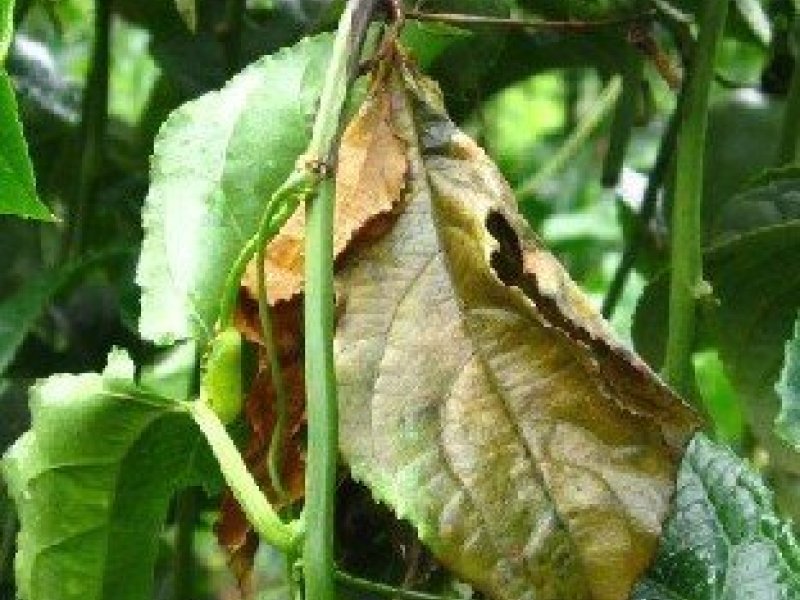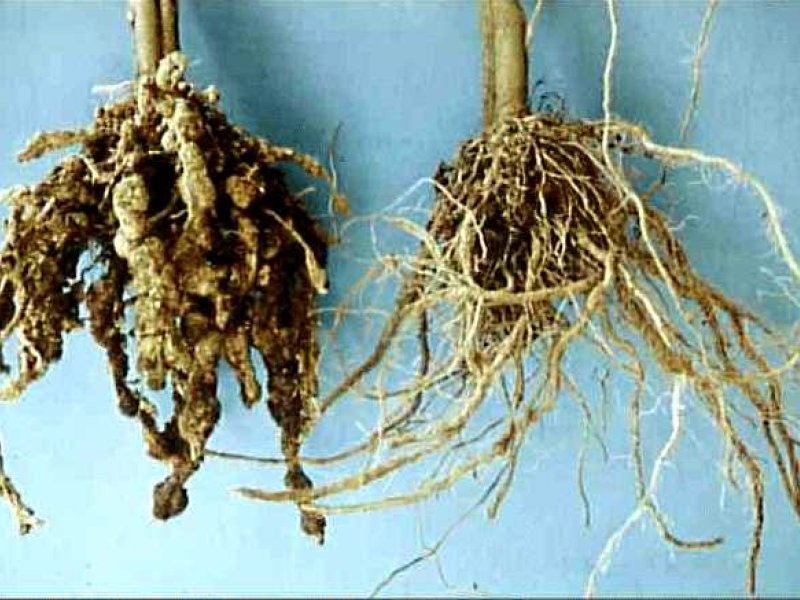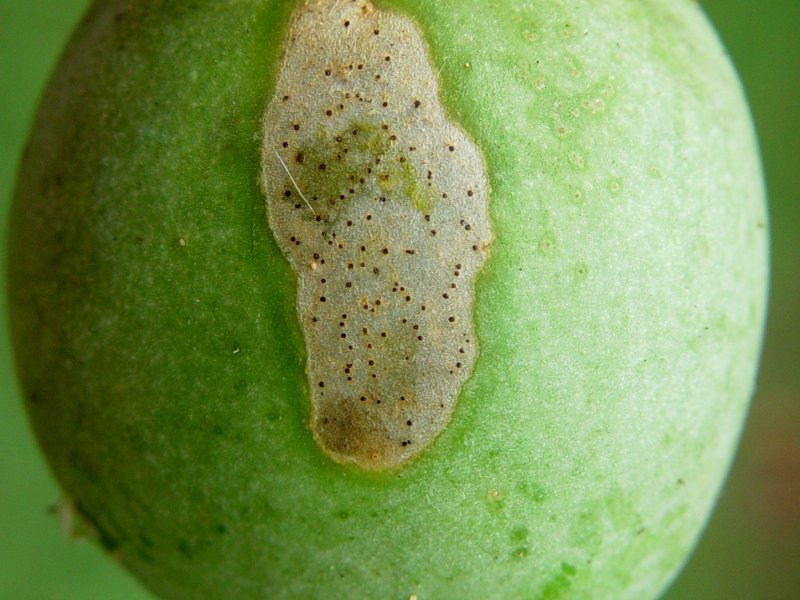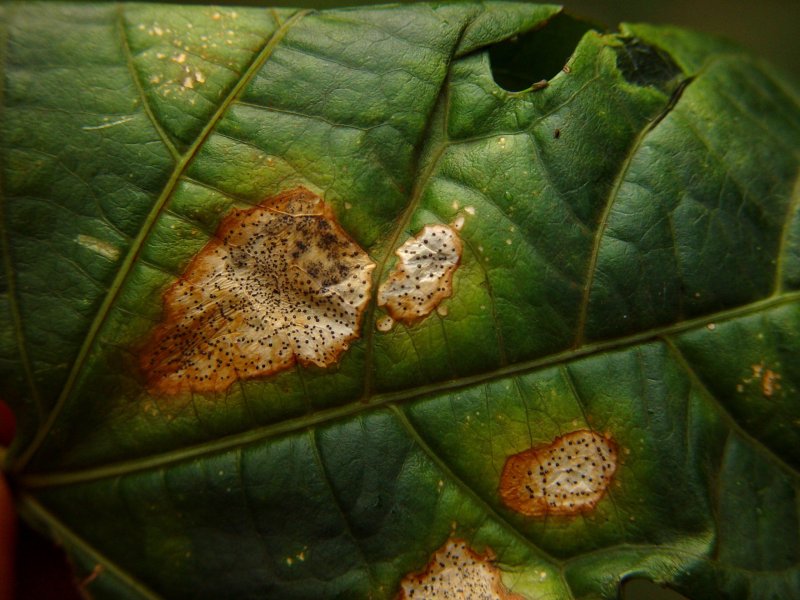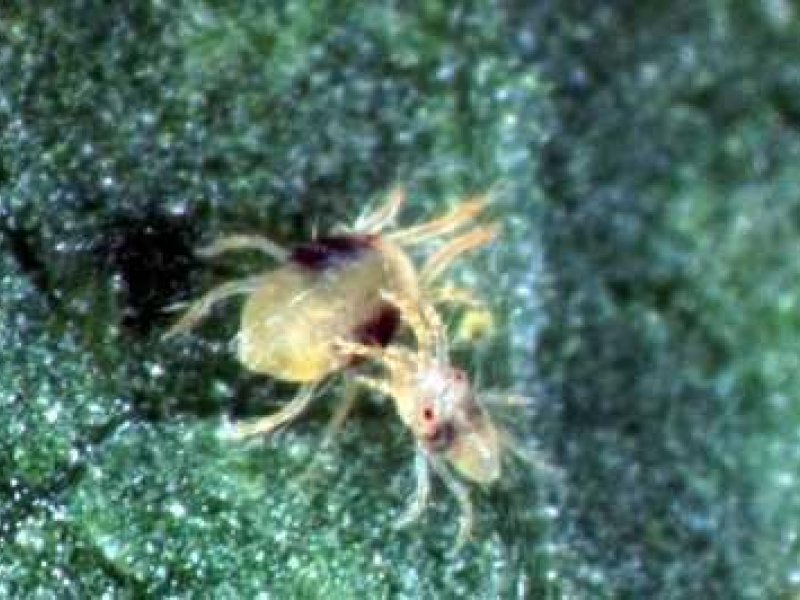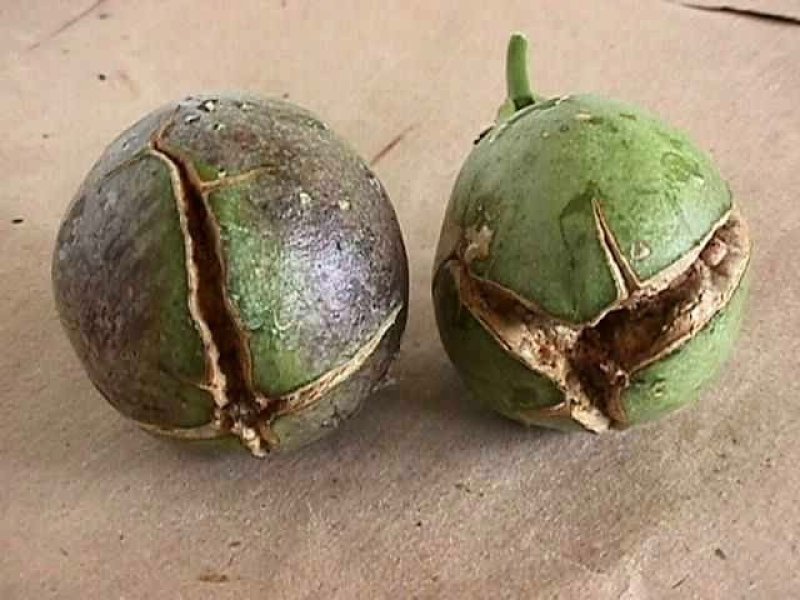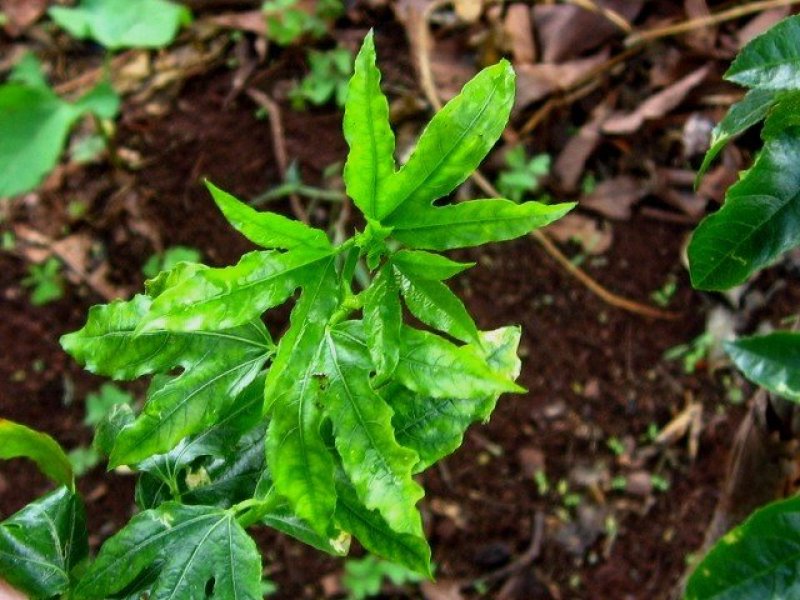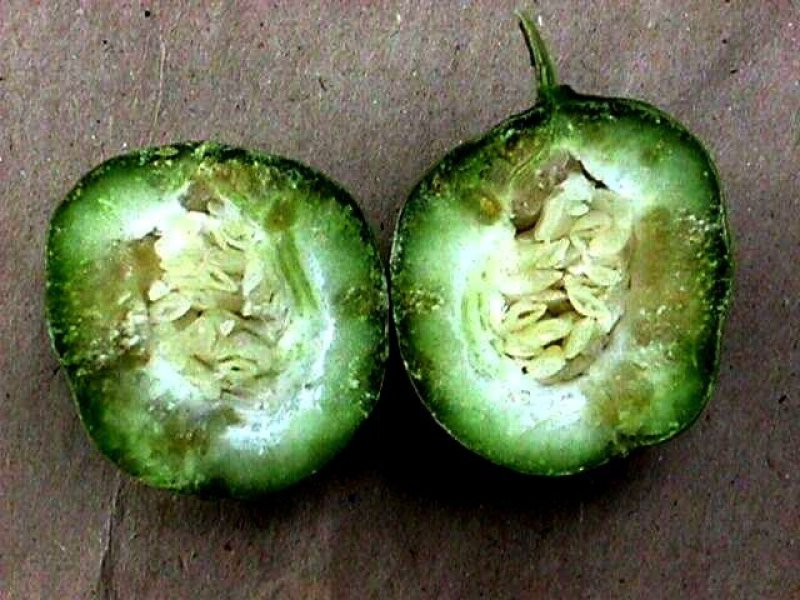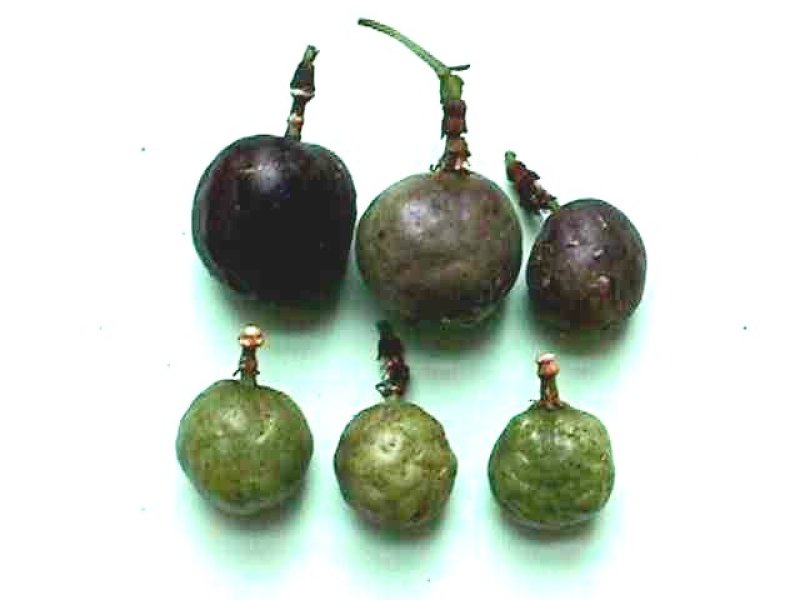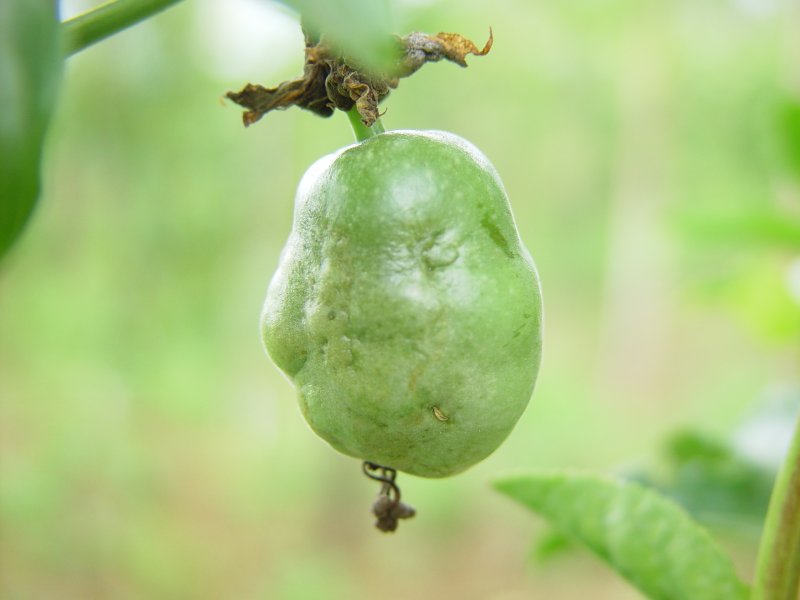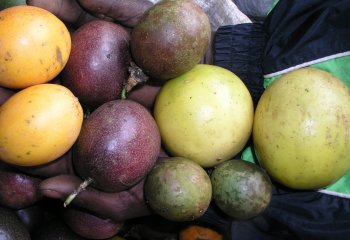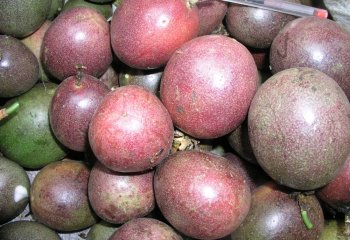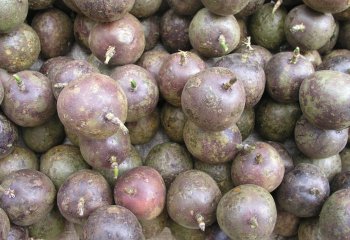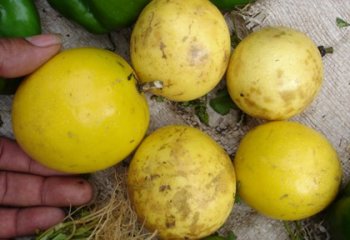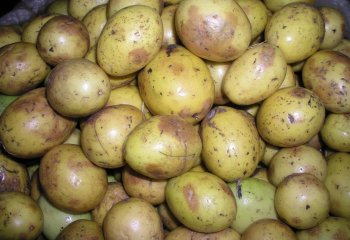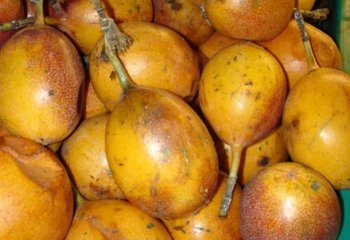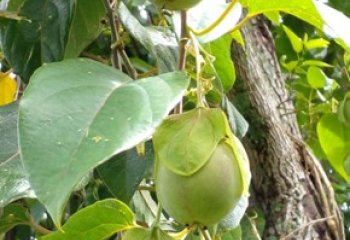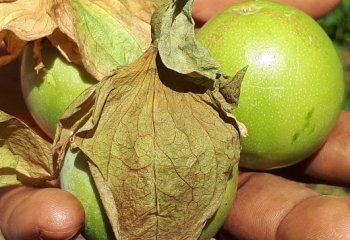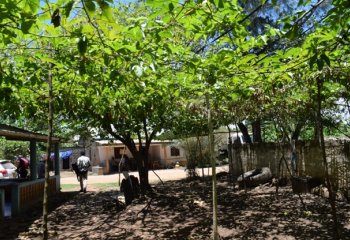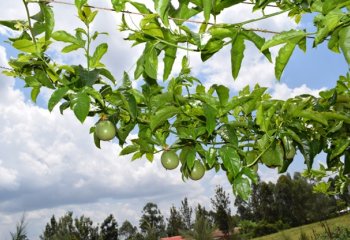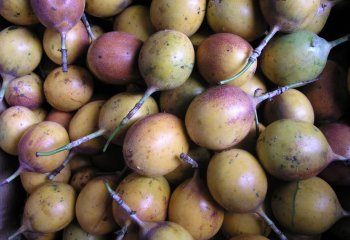|
Aphids (Aphis gossypii and Myzus persicae) Aphids damage plants by sucking plant sap causing curling, wrinkling or cupping of infested leaves, giving plants a deformed shape. They spread viruses and excrete honeydew, which coat the plants and leads to growth of sooty mould, which can diminish the photosynthetic capacity of plants. Aphids are usually controlled by natural enemies if they have not been disturbed for instance by the use of broad-spectrum pesticides.
|
|
|
What to do:
|
|
Broad mite or yellow tea mite (Polyphagotarsonemus latus) It is the most important mite pest of passion fruit in Kenya. Broad mites are tiny (0.1-0.2 mm long) and cannot be seen with the naked eye, and are even difficult to detect with a hand lens. An attack by the broad mites can be detected by the symptoms of damage.
Their feeding produces discolouration, necrosis of tissues and deformation. Initial attack occurs on stems of terminal shoots and young terminal leaves. Attacked young leaves are stunted, deformed (slender, twisted or crumpled), fail to elongate and finally may wilt and dry. Stems of terminal shoots may become slightly swollen, roughened or russeted. As a result the growth of the plant is affected and flower production reduced causing considerably yield reduction. A bronzed dusty appearance may occur on affected plant parts. Attacked fruits become deformed and show white to tan or brown scars on the skin. This damage usually does not affect the internal quality of fruits but affect their market value. Severely attacked fruits may fall. Symptoms remain for a long period of time after control.
|
|
|
What to do:
|
|
Brown spot (Alternaria passiflorae) The most important disease worldwide is brown spot on leaves, vines and fruits. Symptoms are brown spots, up to 10 mm diameter, on the leaves, often extending along the veins and drying out in the centre. On the stems, spots are up to 30 mm long, and when they occur at the leaf axils may kill the vine, resulting in dieback. On the fruit, the spots are light brown, round and sunken; they often merge, covering large areas, and produce red-brown spore masses. Spores, produced on the leaf, stem and fruit, are dispersed by wind-blown rain. Warm, moist weather favours disease development. (EcoPort)
|
|
|
What to do:
|
|
Bugs Several species of sucking bugs feed on passion fruit. The most important are:
The green stinkbug (Nezara viridula) The brown stinkbug (Boerias maculata) Coreid bugs such as the giant coreid bug or tip wilter (Anoplocnemis curvipes) and the leaf footed plant bug (Leptoglossus membranaceus).
Bugs suck sap from the growing tips or developing fruits. The bugs pierce the terminal buds, which eventually wilt and die back. Young plants may be killed if the attack is severe. The punctured young fruits develop localised hardened spots that remain on the fruit reducing their market value.
|
|
|
What to do:
|
|
Fruit flies (Bactrocera cucurbitae and Ceratitis capitata) Fruit flies that feed on passion fruit in Africa include the melon fly (Bactrocera cucurbitae) and the Mediterranean fruit fly (Ceratitis capitata).
Pierced young fruit shrivels and falls; later injuries cause damage that lowers the market value of the fruit. However, the incidence of fruit flies on passion fruit is low, and usually of not economic importance. So control may not be necessary.
|
|
|
What to do:
|
|
Fusarium wilt (Fusarium oxysporum f.sp. passiflorae) Fusarium wilt (also called collar rot) symptoms consist of yellowing of leaves, the collar region of affected plant at soil level turns brownish and vertically cracks and vines wilt followed by a complete collapse of the plant. On dissection of infected stem, vascular tissues show brown discolouration.
|
|
|
What to do:
|
|
Leafmining flies (Lyriomyza spp) Feeding and egg laying by leafmining flies cause stippling of leaves. This can kill seedlings and in older plants allows entry of disease-causing microorganisms. Feeding by maggots causes mining (tunnelling) of leaves reducing the productive leaf area. Heavily attacked leaves may drop off, and may lead to yield losses.
|
|
|
What to do:
|
|
Mealybugs (Planococcus citri and P. kenya) Mealybugs infest fruits and foliage. They can be serious pests in the warm season, if natural enemies, which usually control them, are destroyed by spraying with pesticides.
They are 3-5 mm long, soft, elongate oval and somewhat flattened |
|
|
What to do:
|
|
Phytophthora blight (Phytophthora nicotianae var. parastica) Affected leaves are water-soaked and light-brown in colour. They fall readily, leading to defoliation of the vines. Affected areas of the stem are first purple and later brown above the graft union. They may completely girdle the stem causing wilting and collapse of the vine. Fruit symptoms comprise of large, water-soaked areas. Diseased fruits fall readily and in wet weather become covered with white, fungal growth. Another strain of the fungus (Phytophthora cinnamoni) causes root rot. Yellow and purple varieties have different patterns of susceptibility. The yellow vine is susceptible to P. cinnamoni, and the purple vine is more susceptible to P. nicotianae. Both fungus strains attack both passion fruits and can cause root rot, wilt, damping off and leaf blight. Fungal spores are initially produced in wet soil beneath the vines and are splashed up to lower leaf canopy. The disease is favoured by wet, windy weather.
|
|
|
What to do:
|
|
Nematodes Amongst nematodes infesting passion fruit the root-knot nematodes (Meloidogyne incognita, M. javanica and M. arenaria), are the most serious pests. Characteristic symptoms of infestation by root-knot nematodes are formation of galls or knots on roots, yellowing of leaves, stunting and eventual wilting of the affected plants.
|
|
|
What to do:
|
|
Septoria spot (Septoria passiflorae) The disease attacks leaves, stems and fruits. Brown spots up to 2 mm with minute, black dots (fruiting bodies containing fungal spores) develop on leaf surface. Infected leaves fall readily leading to defoliation of vines. Similar spots may form on the stems albeit elongated. On fruits light-brown spots studded with minute black dots may be formed. The spots often join up to cover large areas of the fruit. Affected fruits ripen unevenly. Spores produced by black dots (fruiting bodies) are blown to adjacent vines during wet, windy weather thus further spreading the disease. The disease is spread by rain, dew and overhead irrigation. Warm moist weather favours disease development.
|
|
|
What to do:
|
|
Spider mites (Tetranychus spp.) Their feeding causes tiny yellow or white speckles, eventually leaves become yellowish and may drop, and may led to complete defoliation. Heavily infested plants may become stunted. A heavy infestation might also cause vine dieback and shrivelling and dropping of immature fruit.
|
|
|
What to do:
|
|
Passion fruit woodiness potyvirus (PWV) A number of virus diseases have been reported, notably the passion fruit woodiness potyvirus. Affected leaves show light and dark green mosaic pattern often with light yellow speckle. Sometimes small, yellow ring spots may develop on upper leaf surface. Infected fruits are small and misshapen with very hard rind and small pulp cavity. When affected fruit is cut, the inside rind tissue may have brown spots. Some strains of the virus cause cracking of affected fruits. They are spread by aphids (Aphis gossypii and Myzus persicae) grafting and pruning knives. The virus has a wide host range including bananas, cucurbits and many weeds.
|
|
|
What to do:
|
Geographical Distribution in Africa
Geographical Distribution of Passion Fruit in Africa. Updated on 8 July 2019. Source FAOSTAT
© OpenStreetMap contributors, © OpenMapTiles, GBIF. https://www.gbif.org/species/2874190.
General Information and Agronomic Aspects
Introduction
Passion fruit (Passiflora edulis) is a native of southern Brazil where it grows on the edges of rain forests. Passion fruit is a fruit-bearing vine belonging to the Passifloraceae family and the Passiflora genus. The family comprises around 17 genera and over 700 species, with Passiflora being the largest genus within this family, consisting of approximately 550 species. Passiflora edulis is particularly renowned for its delicious and aromatic purple passion fruit, but there is also a variety known as P. edulis var. flavicarpa or Yellow Passion Fruit, which is of economic significance as well. The Purple Passion Fruit is believed to have originated in the Amazon region of South America, particularly in Brazil. However, it has been cultivated and naturalized in various tropical and subtropical regions worldwide. It is now commonly grown in warm climates worldwide.
© Maundu P, 2006
Passion fruits are highly valued for their unique sweet-tart flavor and aroma, making them popular as fresh fruits, juices, and various culinary applications. The fruit may be eaten fresh, but mostly the pulp is extracted and preserved by heating or cooling. The juice has a unique and intense flavour and high acidity, which makes it a natural concentrate. When sweetened and diluted it is very palatable and blends well with other fruit juices. The seeds and pulp are commonly used to add flavor to desserts, salads, and sauces. Additionally, passion fruit is rich in vitamins and antioxidants, making it a nutritious choice. In the agricultural sector, the fruits are typically processed into ice cream, sherbet, nectar, juices, concentrate, squash, jams, jellies and various other products. This allows for a longer shelf life and creates additional revenue streams for farmers and producers.
Apart from being a food source, passion fruit vines are often cultivated as ornamentals for their showy flowers and are used to cover fences, trellises, and walls in gardens and landscapes
Passiflora plants are often cultivated as ornamentals for their showy flowers. Passion flowers are widely employed by herbalists and natural health practitioners around the world today. They are mostly employed as a sedative, hypnotic (inducing sleep), nervine, anti-spasmodic and pain reliever.
In the global market, passion fruit and its products are in high demand due to their unique flavor and nutritional value. The fruit is not only consumed locally in producing countries but is also exported to many parts of the world. In Africa, major producers of passion fruit include Kenya, Uganda, and South Africa. Kenya stands out as one of the major producers of passion fruit, with both purple and yellow varieties being cultivated. The passion fruit, a perennial climbing plant was introduced into Kenya in the 1920's. It is now a popular fruit for both domestic and export markets. From 2001 to 2005 export from Kenya of passion fruit was around 1,000 tons per year, against a total production of around 30,000 tons yearly.
There are two distinct forms: forma edulis, the purple passion fruit, occurs in cool environments at higher altitudes, and forma flavicarpa, the yellow passion fruit, which is at home in the tropical lowlands. The two types were distributed throughout the tropics and subtropics via Europe and Australia during the 19th century.
Species account
1. Passiflora edulis (purple passion fruit)
This passion fruit is a native of southern Brazil where it grows on the edges of rain forests. It is a perennial climbing plant. It is now a popular fruit for both domestic and export markets.
There are two distinct forms: forma edulis, the purple passion fruit, occurs in cool environments at higher altitudes, and forma flavicarpa, the yellow passion fruit, which is at home in the tropical lowlands. The two types were distributed throughout the tropics and subtropics via Europe and Australia during the 19th century. P. edulis var. flavicarpa. Hybrids can be made between purple and yellow passion fruit, which yields intermediates between the two forms. Passion fruit was introduced into Kenya in the 1920's.
Forma edulis, the purple passion fruit
Principal characteristics of the purple type:
• Purple rind and smaller fruit
• Sweet less acidic pulp richer in aroma and flavour and has a higher proportion of juice (35-38%)
• Can self-pollinate but pollination is best under humid conditions
• Less vigorous vine
• If crossing yellow and purple types, it is necessary to use the purple parent as the seed parent because the flowers of the yellow are not receptive to the pollen of the purple, and an early blooming yellow must be utilised in order to have a sufficient overlapping period for pollen transfer. These crosses have some ability to withstand? woodiness? virus.
• Black seeds
Ⓒ Maundu, 2005
Principal characteristics of the yellow type:
• Yellow rind and larger fruit
• More acid flavour
• Flowers are self-sterile - wind is ineffective because of the heaviness and stickiness of the pollen. They must be pollinated, and carpenter bees are the most efficient pollinators.
• More vigorous vine
• More tolerant of frost
• Resistant to nematodes and Fusarium wilt
• Brown seeds
© Maundu 2005
Ⓒ Foods of Nairobi people, 2005
Ⓒ Foods of Nairobi people, 2005
2. Passiflora ligularis- sweet granadilla
This fruit has a good flavor and is quite sweet. The peel is resistant so the fruit can be transported well, without being damaged.
3. Passiflora maliformis- sweet calabash, sweet cup, stone passion
This is a climbing perennial with a round hard fruit, often hard to crack. It is normally found in medium to high rainfall areas. In Kenya, it is found in Vihiga county of Kenya. It is a little-known species but with great potential due to its good aroma and flavor.
© Maundu, 2021
4. Passiflora quadrangularis- Giant Granadilla
This is an extensive climber with thick vines, large leaves and a larger fruit than of any other passion fruit. It is found in high rainfall areas such as the western part of Kenya in mid altitudes.
P. quadrangularis is widely distributed in the tropics but is most important in S. America. It bears the largest fruits, which can be up to 25 cm long, and fleshy instead of hollow. The seeds are much larger, brownish, and flattened. The rind is not as hard as in the purple and yellow passion fruits. The juice content is much lower and is somewhat inferior in flavor and color. The pulp can be eaten like a melon. When green, this fruit can be used as a vegetable.
(Further reading: D.B. Rodriguez-Amaya, in Encyclopedia of Food Sciences and Nutrition (Second Edition), 2003)
5. Passiflora mollissima- Banana passion fruit or curuba
This is an extensive climber found in cool highlands. It is common in the highland forests of Kenya from where it is harvested and sold. It is also cultivated along hedges. The ripe fruit is narrow, yellow and nearly cylindrical, somewhat resembling a small ripe banana, hence the name.
|
Variety Name |
Origin and Characteristics |
|
Australian Purple or Nelly Kelly |
Mild sweet flavour |
|
Common Purple |
Naturalised Hawaiian variety. Thick skinned with small cavity |
|
Kapoho Selection |
A cross of yellow Hawaiian strains. A heavy bearer but subject to brown rot. |
|
Black Knight |
Purple cultivar |
|
Bountiful Beauty |
Purple cultivar |
|
Sevcik Selection |
Golden form of the yellow, a heavy bearer but subject to brown rot. |
|
University Round Selection |
Hawaiian cross small fruit and not attractive but high juice yield. |
|
Nelly Kelly |
Australian purple cultivar |
|
Waimanalo Selection |
Consists of four strains, C-54, C-77, C-80 of similar size, shape and colour and C-39 as a pollinator. |
|
Nancy Garrison |
Purple cultivar |
|
Yee Selection |
Yellow, round, attractive and highly disease resistant. |
|
Ester |
Very large purple fruit ? variety imported as large passion fruit. |
|
Purple Giant |
Purple cultivar |
|
Kahuna |
Very large medium purple fruit good for juicing and produces over a long season |
Ecological conditions
The yellow passion fruit grows best at altitudes of 0-800 m and is used mainly for the fresh fruit market. It can also be used as a rootstock for grafting of the purple variety; the purple passion fruit forms virtually no flowers below 1000 m and should be grown at altitudes of 1200-2000 m.
The mature purple passion fruit tolerates light frosts and can be grown in the subtropics. Other varieties exist such as the so-called banana passion fruit growing in highland areas and often climb very tall trees. It is yellow at maturity but with soft velvety skin and pink flowers quite different from the commercial passion fruits. The banana passion fruit is mainly used in sweetened juices, as it is not usually very sweet on its own.
All varieties grow on a wide range of soils; but light to heavy sandy loams, of medium texture and at least 60 cm deep are most suitable. Heavy clay soils have to be drained and very sandy ones need heavy manuring. A pH of 5.5-7 is preferred. If the soil is too acidic, lime must be applied. Good drainage and aeration are essential to minimise the incidence of diseases such as collar rot.
Purple passion fruit, especially, grows well on as little as 900 mm rainfall in Africa, provided the rainfall is well distributed. The vines require sheltered locations without extreme temperatures: Optimum temperatures for the purple variety are between 18-25degC and for the yellow variety 25-30degC. Critical temperatures were established for hybrid cultivars in Australia as follows: below 20degC pollen does not germinate and at 18-15degC both growth and flowering are set back, whereas temperatures above 30-32degC stimulate growth at the expense of flowering and fruit set (CABI).
Agronomic aspects
Passion fruit is generally propagated from seed, although cuttings and grafting can be used. Seed should be rubbed clean of pulp and dried in the shade. Germination takes 2-4 weeks. Fresh seeds are much easier to germinate than seeds older than one or two months. Older seeds can be soaked for at least one day to improve germination. Seedlings are often raised in polythene bags, 15 cm wide and 25 cm deep. Three seeds per bag are sown at a depth of 1 cm and thinned to leave one after two months. Cuttings are set in coarse sand and later transplanted into bags or a nursery bed. The seedlings grow slowly and require 3-4 months to reach the transplanting height of 15-25 cm. Seedlings must be hardened off by leaving them in an open, shaded area for a day or two.
Grafting is often used to control diseases. Yellow passion fruit is used as resistant rootstock although other Passiflora species, in particular P. caerulea L., show much greater resistance to Phytophthora root rot and Fusarium collar rot. Moreover, P. caerulea is tolerant of root-knot nematodes and to exposure to -1.5degC; it can be propagated from leaf and stem cuttings and is compatible with P. edulis. Wedge and whip grafts on seedling rootstocks - sometimes on rooted cuttings - are used.
Within 5-7 weeks after transplanting, each plant will have up to four healthy laterals. From then on the vine grows very rapidly; the first flowers are produced 5-7 months after transplanting when the vine can be 10-15 m long.
Light is the essential factor for flowering and in passionfruit this is particularly true for floral development and fruit set. That is why training and pruning are important to ensure adequate exposure of the shoots. Depending on the climate there may be one to three harvest peaks (purple passionfruit) or a single, often very long harvest season (more common with the yellow passion fruit).
Land preparation
Deep ploughing and harrowing is necessary to remove hard pans in the soil. Passion fruit has a deep root system; therefore proper land cultivation is necessary. Commercial plantations adopt a row spacing of 1.2-1.8 m and a within-row spacing of 3 m. This gives around 1,900 - 2,700 plants/ha. Planting holes of 45 x 45 x 45 cm should be filled with topsoil mixed with up to 10 kg of compost or manure. Transplanting is done at the start of the rainy season.
At planting the soil around the plants should be firmed down to establish good root/soil contact. In order to avoid fungal infection the grafting spot should not have any contact with the soil during and after planting. The seedling should then be irrigated to ensure quick rooting and establishment of the plant.
Husbandry
Early growth of passion fruit is slow and regular weeding is essential. Care should be taken when weeding in order to avoid any injury to the plant. Mulching along the rows or around the base of the plants greatly facilitates weed control and protects the roots. Elaborate trellises have been used in Australia and South Africa, but in East Africa, especially at closer spacing, a single wire trellis has been found to be as good. A 14-gauge galvanized wire is tightly stretched along the tops of hardwood posts 15 cm in diameter and 3 m long, dug in to a depth of 0.6 m; these posts are spaced 8 m apart. The trellis should be erected when the field is planted so that the main shoot and one vigorous lateral can be tied to the wire with a string. If laterals do not emerge in time, they can be forced to leaf out by pinching off the shoot tip. When the vines reach the wire they are trained in opposite directions along it. All laterals below the wire are pruned off. Laterals emerging along the wire are allowed to hang down freely; they are the secondary shoots branching into tertiary shoots. Secondary and higher-order shoots are the fruiting wood, which has to be thinned and rejuvenated by pruning.
Regular fertilisation is necessary for optimum yields. Frequent sprays with compost tea or similar organic foliar feed should be applied starting from 1 month after planting and at least every 3 months after that. Mixing EM or BM with foliar sprays may prevent fungal attacks.
© Maundu, 2022
Pruning
Old unproductive shoots and dead wood must be removed. Also secondary shoots reaching the ground must be cut off about 5 cm above the ground. The laterals which bear fruit should be left to hang down freely from the wire and the entangling tendrils removed to allow free air and light penetration and reduce incidences of disease and pest epidemics. Disinfect with commercial detergent all equipment used for pruning regularly to avoid spread of viral diseases.
Intercropping
A wide range of vegetables and other crops can be intercropped with passion fruit. Intercropping with annuals is recommended; especially vegetables like beans, cabbages and tomatoes are agronomically suitable. Other recommended crops include potatoes, beetroots, Swiss chard, carrots, spinach, strawberries, eggplants, peppers, onions, leeks and head lettuce. However, cucurbits (cucumbers, pumpkin, and squashes) are not recommended due to the woodiness virus and fruit flies. Other crops that should not be intercropped with passion fruits are maize, cowpea, sorghum, okra, sweet potatoes and other creepers (GTZ, 1978). Intercropping can help in erosion control particularly when fed with good compost.
Rotation
To avoid build up of soil-borne diseases strict crop rotation should be practised (see suitable crops under intercropping). Passion fruits should not be grown for more than 2-3 years on the same plot.
Yield
Harvest, post-harvest practices and markets
Fruit drops to the ground when fully mature. It is collected every second day; at this stage it looks shriveled and unattractive, but for processing fruits should be picked at this stage. For fresh fruit markets, especially the export market, fruit is picked after full colour development when the whole fruit is purple or canary yellow, but before shriveling and drying set in.
Markets
Passion fruits, particularly the common passion fruit and the sweet granadilla are generally in high demand throughout the year. As the supply is normally low, they are normally a bit more expensive than many other fruits.
© Maundu, 2005.
© Maundu, 2005
Nutritional value
Table 1: Proximate nutritional value of 1000g of passion fruit
Code Food Name |
Passion fruit, dark purple skin, raw |
Recommended daily allowance (approx.) for adultsa |
Edible conversion factor |
0.52 |
|
Energy (kJ) |
313 |
9623 |
Energy (kcal) |
75 |
2300 |
Water (g) |
75.7 |
2000-3000c |
Protein (g) |
2.4 |
50 |
Fat (g) |
[0.9] |
<30 (male), <20 (female)b |
Carbohydrate available (g) |
8.7 |
225 -325g |
Fibre (g) |
11.7 |
30d |
Ash (g) |
0.8 |
|
Minerals |
||
Ca (mg) |
10 |
800 |
Fe (mg) |
0.6 |
14 |
Mg (mg) |
28 |
300 |
P (mg) |
68 |
800 |
K (mg) |
200 |
4,700f |
Na (mg) |
19 |
<2300e |
Zn (mg) |
0.8 |
15 |
Se (mcg) |
1 |
30 |
Bioctive compounds. |
||
Vit A RAE (mcg) |
64 |
800 |
Vit A RE (mcg) |
127 |
800 |
Retinol (mcg) |
0 |
1000 |
b-carotene |
764 |
600 – 1500g |
Thiamin (mg) |
0.03 |
1.4 |
Riboflavin (mg) |
0.14 |
1.6 |
Niacin (mg) |
2.5 |
18 |
Dietary Folate Eq. (mcg) |
7 |
400f |
Food folate (mcg) |
7 |
400f |
Vit B12 (mg) |
0 |
3 |
Vit C (mg) |
29 |
60 |
Source (Nutrient data): FAO/Government of Kenya. 2018. Kenya Food Composition Tables. Nairobi, 254 pp. http://www.fao.org/3/I9120EN/i9120en.pdf
RE=retinol equivalents.
RAE =Retinol activity equivalents. A RAE is defined as 1μg all-trans-retinol, 12μg beta-carotene, or 24μg α-carotene or β-cryptoxanthin.
a Lewis, J. 2019. Codex nutrient reference values. Rome. FAO and WHO
b NHS (refers to saturated fat)
c https://www.hsph.harvard.edu/nutritionsource/water/
d British Heart Foundation
e FDA
f NIH
g Mayo Clinic
Noteworthy values are in bold.
Nutritional composition of purple and yellow passion fruit juice.
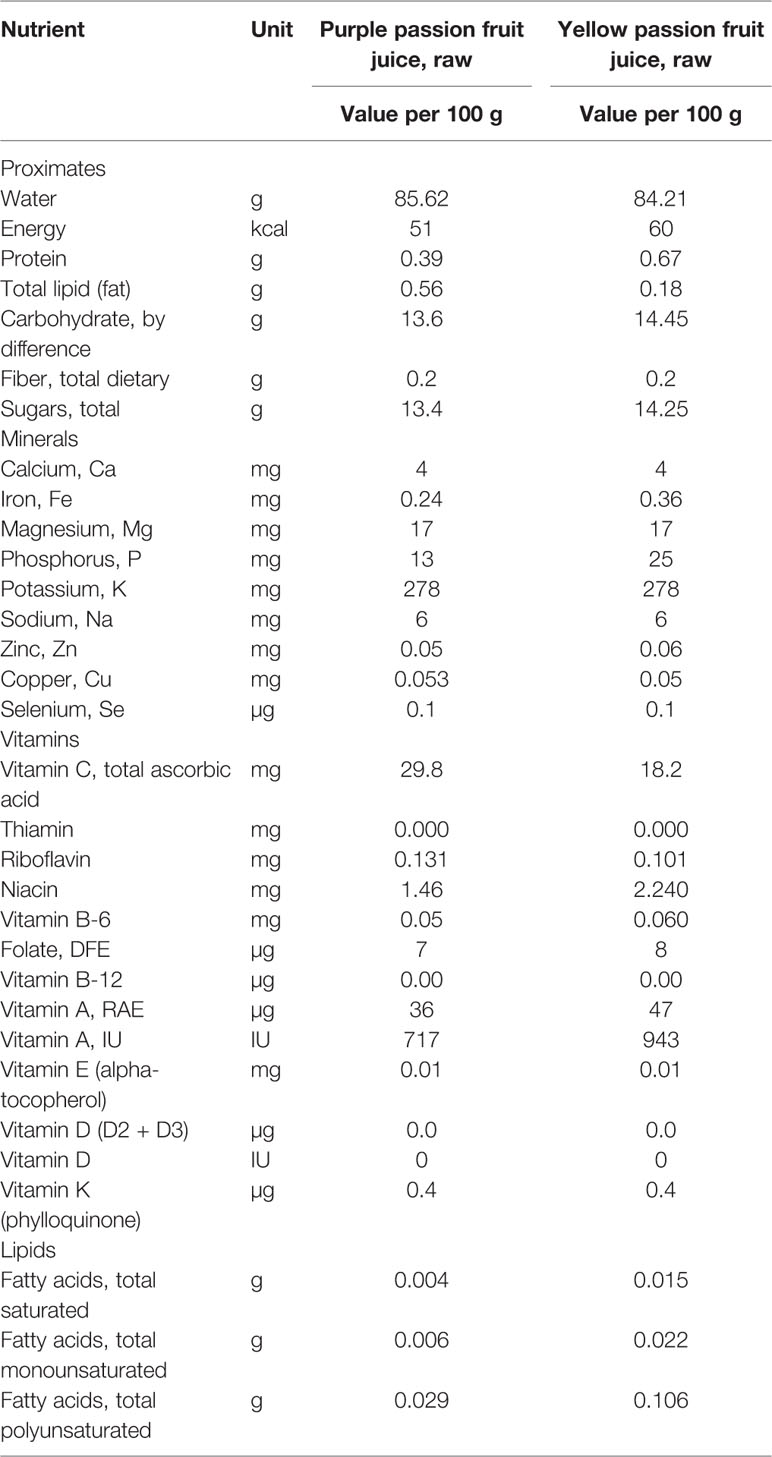
Source: (USDA Food Composition Databases, 2019)
Nutritive Value per 100 g of edible Portion
| Raw or Cooked Passion fruit | Food Energy (Calories / %Daily Value*) |
Carbohydrates (g / %DV) |
Fat (g / %DV) |
Protein (g / %DV) |
Calcium (g / %DV) |
Phosphorus (mg / %DV) |
Iron (mg / %DV) |
Potassium (mg / %DV) |
Vitamin A (I.U) |
Vitamin C (I.U) |
Vitamin B 6 (I.U) |
Vitamin B 12 (I.U) |
Thiamine (mg / %DV) |
Riboflavin (mg / %DV) |
Ash (g / %DV) |
| Purple Passion fruit raw | 97.0 / 5% | 23.4 / 8% | 0.7 / 1% | 2.2 / 4% | 12.0 / 1% | 68.0 / 7% | 1.6 / 9% | 348 / 10% | 1272 IU / 25% | 30.0 / 50% | 0.1 / 5% | 0.0 / 0% | 0.0 / 0% | 0.1 / 8% | 0.8 |
| Purple Passion Fruit Juice raw | 51.0 / 3% | 13.6 / 5% | 0.1 / 0% | 0.4 / 1% | 4.0 / 0% | 13.0 / 1% | 0.2 / 1% | 278 / 8% | 717 IU / 14% | 29.8 / 50% | 0.1 / 3% | 0.0 / 0% | 0.0 / 0% | 0.1 / 8% | 0.3 |
| Yellow Passion Fruit Juice raw | 60.0 / 3% | 14.5 / 5% | 0.2 / 0% | 0.7 / 1% | 4.0 / 0% | 25.0 / 2% | 0.4 / 2% | 278 / 8% | 943 IU / 19% | 18.2 / 30% | 0.1 / 3% | 0.0 / 0% | 0.0 / 0% | 0.1 / 6% | 0.5 |
*Percent Daily Values (DV) are based on a 2000 calorie diet. Your daily values may be higher or lower, depending on your calorie needs.
Information on Pests
Biological methods of plant protection
Nematodes, especially the root-knot nematodes (Meloidogyne incognita, M. javanica and M. arenaria), are the most serious pests on passion fruit. Practical control measures are crop rotation and the use of tolerant rootstocks.
Several species of sucking bugs feed on passion fruit. They suck and pierce leaves and young fruits; these are minor pests.
Fruit flies that feed on passion fruit include the melon fly (B. cucurbitae) and the Mediterranean fruit fly (Ceratitis capitata) and the Queensland fruit fly (B. tryoni). Pierced young fruit shrivels and falls; later injuries cause damage which lowers the grade. Spraying of biopesticides may be necessary if destruction of infested fruit and the use of baits do not adequately check the pest.
Mealybugs (Planococcus citri and P. kenyae) are usually controlled by their natural enemies.
The same to applies mites the red spider mites and the broad mites - which incidentally do much damage.
Examples of Passion Fruit Pests and Organic Control Methods
| Mealybugs (Planococcus citri and P. kenya) Mealybugs infest fruits and foliage. They can be serious pests in the warm season, if natural enemies, which usually control them, are destroyed by spraying with pesticides.
They are 3-5 mm long, soft, elongate oval and somewhat flattened What to do:
|
| Aphids (Aphis gossypii and Myzus persicae) Aphids damage plants by sucking plant sap causing curling, wrinkling or cupping of infested leaves, giving plants a deformed shape. They spread viruses and excrete honeydew, which coat the plants and leads to growth of sooty mould, which can diminish the photosynthetic capacity of plants. Aphids are usually controlled by natural enemies if they have not been disturbed for instance by the use of broad-spectrum pesticides.
What to do:
|
| Leafmining flies (Lyriomyza spp) Feeding and egg laying by leafmining flies cause stippling of leaves. This can kill seedlings and in older plants allows entry of disease-causing microorganisms. Feeding by maggots causes mining (tunnelling) of leaves reducing the productive leaf area. Heavily attacked leaves may drop off, and may lead to yield losses.
What to do:
|
| Several species of sucking bugs feed on passion fruit. The most important are:
The green stinkbug (Nezara viridula) The brown stinkbug (Boerias maculata) Coreid bugs such as the giant coreid bug or tip wilter (Anoplocnemis curvipes) and the leaf footed plant bug (Leptoglossus membranaceus).
Bugs suck sap from the growing tips or developing fruits. The bugs pierce the terminal buds, which eventually wilt and die back. Young plants may be killed if the attack is severe. The punctured young fruits develop localised hardened spots that remain on the fruit reducing their market value.
What to do:
|
| Fruit flies (Bactrocera cucurbitae and Ceratitis capitata) Fruit flies that feed on passion fruit in Africa include the melon fly (Bactrocera cucurbitae) and the Mediterranean fruit fly (Ceratitis capitata).
Pierced young fruit shrivels and falls; later injuries cause damage that lowers the market value of the fruit. However, the incidence of fruit flies on passion fruit is low, and usually of not economic importance. So control may not be necessary.
What to do:
|
| Spider mites (Tetranychus spp.) Their feeding causes tiny yellow or white speckles, eventually leaves become yellowish and may drop, and may led to complete defoliation. Heavily infested plants may become stunted. A heavy infestation might also cause vine dieback and shrivelling and dropping of immature fruit.
What to do:
|
| Broad mite or yellow tea mite (Polyphagotarsonemus latus) It is the most important mite pest of passion fruit in Kenya. Broad mites are tiny (0.1-0.2 mm long) and cannot be seen with the naked eye, and are even difficult to detect with a hand lens. An attack by the broad mites can be detected by the symptoms of damage.
Their feeding produces discolouration, necrosis of tissues and deformation. Initial attack occurs on stems of terminal shoots and young terminal leaves. Attacked young leaves are stunted, deformed (slender, twisted or crumpled), fail to elongate and finally may wilt and dry. Stems of terminal shoots may become slightly swollen, roughened or russeted. As a result the growth of the plant is affected and flower production reduced causing considerably yield reduction. A bronzed dusty appearance may occur on affected plant parts. Attacked fruits become deformed and show white to tan or brown scars on the skin. This damage usually does not affect the internal quality of fruits but affect their market value. Severely attacked fruits may fall. Symptoms remain for a long period of time after control.
What to do:
|
| Amongst nematodes infesting passion fruit the root-knot nematodes (Meloidogyne incognita, M. javanica and M. arenaria), are the most serious pests. Characteristic symptoms of infestation by root-knot nematodes are formation of galls or knots on roots, yellowing of leaves, stunting and eventual wilting of the affected plants.
What to do:
|
Information on Diseases
Biological methods of plant protection. The most important disease on passion fruit is brown spot (Alternaria passiflorae) on leaves, vines and fruits. Phytophthora blight (Phytophthora nicotianae) causes the wilting of shoot tips and crown rot, particularly where water stagnates occasionally. Septoria spot, caused by the fungus Septoria passiflorae, causes extensive spotting of leaf and fruit, and occasionally of the stem. Yellow passion fruit and its hybrids are more tolerant to these diseases.
Fusarium wilt (also called collar rot) is caused by the soil-borne fungus Fusarium oxysporum f.sp. passiflorae; the shoots wilt, followed by a complete collapse of the plant. Grafting to wilt-resistant yellow passion fruit rootstocks is the most practical way of control. Damping-off caused by Rhizoctonia solani and Pythium spp. can be a problem in nurseries and soils should be sterilised.
A number of virus diseases have been reported, notably passion fruit woodiness potyvirus (PWV). They are spread by aphids (Aphis gossypii and Myzus persicae) and pruning knives. Other virus diseases are ringspot from Côte d'Ivoire, which is similar to PWV. The most practical control is to use clean planting material, clean pruning tools and resistant hybrids, or rootstocks of yellow passion fruit.
Examples of Passion Fruit Diseases and Organic Control Methods
| Brown spot (Alternaria passiflorae) The most important disease worldwide is brown spot on leaves, vines and fruits. Symptoms are brown spots, up to 10 mm diameter, on the leaves, often extending along the veins and drying out in the centre. On the stems, spots are up to 30 mm long, and when they occur at the leaf axils may kill the vine, resulting in dieback. On the fruit, the spots are light brown, round and sunken; they often merge, covering large areas, and produce red-brown spore masses. Spores, produced on the leaf, stem and fruit, are dispersed by wind-blown rain. Warm, moist weather favours disease development. (EcoPort)
What to do:
|
| Septoria spot (Septoria passiflorae) The disease attacks leaves, stems and fruits. Brown spots up to 2 mm with minute, black dots (fruiting bodies containing fungal spores) develop on leaf surface. Infected leaves fall readily leading to defoliation of vines. Similar spots may form on the stems albeit elongated. On fruits light-brown spots studded with minute black dots may be formed. The spots often join up to cover large areas of the fruit. Affected fruits ripen unevenly. Spores produced by black dots (fruiting bodies) are blown to adjacent vines during wet, windy weather thus further spreading the disease. The disease is spread by rain, dew and overhead irrigation. Warm moist weather favours disease development.
What to do:
|
| Fusarium wilt (Fusarium oxysporum f.sp. passiflorae) Fusarium wilt (also called collar rot) symptoms consist of yellowing of leaves, the collar region of affected plant at soil level turns brownish and vertically cracks and vines wilt followed by a complete collapse of the plant. On dissection of infected stem, vascular tissues show brown discolouration.
What to do:
|
| Phytophthora blight (Phytophthora nicotianae var. parastica) Affected leaves are water-soaked and light-brown in colour. They fall readily, leading to defoliation of the vines. Affected areas of the stem are first purple and later brown above the graft union. They may completely girdle the stem causing wilting and collapse of the vine. Fruit symptoms comprise of large, water-soaked areas. Diseased fruits fall readily and in wet weather become covered with white, fungal growth. Another strain of the fungus (Phytophthora cinnamoni) causes root rot. Yellow and purple varieties have different patterns of susceptibility. The yellow vine is susceptible to P. cinnamoni, and the purple vine is more susceptible to P. nicotianae. Both fungus strains attack both passion fruits and can cause root rot, wilt, damping off and leaf blight. Fungal spores are initially produced in wet soil beneath the vines and are splashed up to lower leaf canopy. The disease is favoured by wet, windy weather.
What to do:
|
| Passion fruit woodiness potyvirus (PWV) A number of virus diseases have been reported, notably the passion fruit woodiness potyvirus. Affected leaves show light and dark green mosaic pattern often with light yellow speckle. Sometimes small, yellow ring spots may develop on upper leaf surface. Infected fruits are small and misshapen with very hard rind and small pulp cavity. When affected fruit is cut, the inside rind tissue may have brown spots. Some strains of the virus cause cracking of affected fruits. They are spread by aphids (Aphis gossypii and Myzus persicae) grafting and pruning knives. The virus has a wide host range including bananas, cucurbits and many weeds.
What to do:
|
References and information links
References
• AIC (2003). Fruits and Vegetables technical handbook, revised edition 2003. Agriculture Information Centre, Nairobi, Kenya
• CAB International (2006). Crop Protection Compendium, 2006 Edition. Wallingford, UK www.cabi.org
• Cooper, J., Dobson, H., Orchard, J. (2004). Passion Fruit Technical Itinerary. NRI - MU/PIP COLEACP, Brussels, Belgium.
• Economic Review of Agriculture 2006. Ministry of Agriculture, Nairobi Kenya
• GTZ. (1978). Passion fruit growing in Kenya. A Recommendation for Smallholders. By German Agricultural team in Kenya.
• Griesbach, J. (1992). A Guide to Propagation and Cultivation of Fruit Trees in Kenya. Published by German Technical Cooperation of Germany (GTZ). ISBN: 3 88085 482 3.
• Integration of Tree Crops into Farming Systems Project (GTZ) & Ministry of Agriculture and Rural Development, Kenya (2000). Tree Crop Propagation and Management - A Farmer Trainer Training Manual.
• Nutrition Data www.nutritiondata.com.
Review Process
Patrick Maundu, James Kioko, Charei Munene, Monique Hunziker, August 2024.

